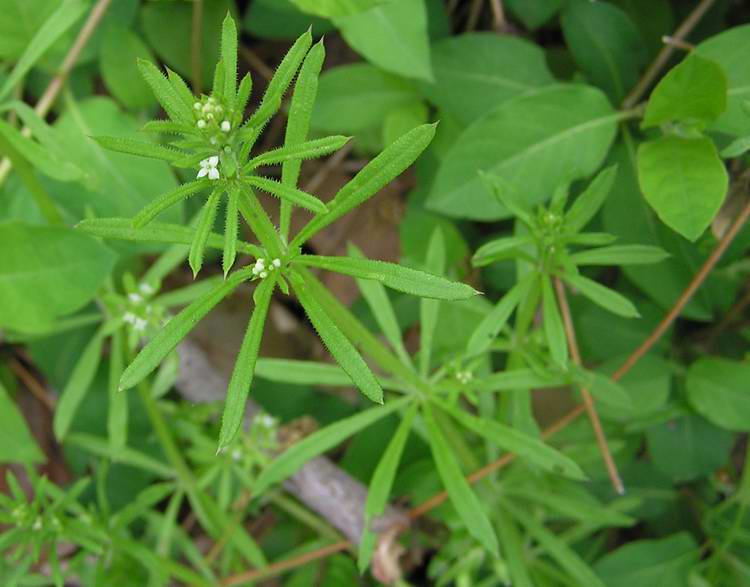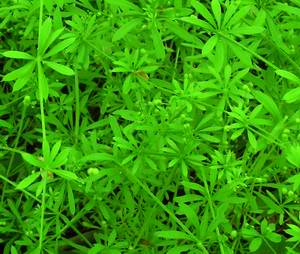
Common Name: Cleavers, Bedstraw, Goosegrass, Cleaverwort, Scarthgrass, Hedgeheriff, Loveman, Robin-run-in-the-grass, Sticky-willy – The stem of the plant is covered with small bristles that attach, or cleave, to any passing object.
Scientific Name: Galium aparine – The generic name is derived from gala, the Greek word for milk – this because a plant of the Galium genus was used in antiquity as a means to curdle milk to make cheese. Numerous references assert that the etymology of the species name is aparo, the Greek word for “seize” – the implication being that the plant seizes (cleaves to) anything that passes.
Potpourri: The diversity of names is evidence of long-standing cultural relationships with the plant. Many of the names obliquely relate to the clinging bristles; Cleavers and Sticky-willy are obvious but Hedgeheriff and Loveman are not. The former is from the Anglo-Saxon “hedge rife” for someone who steals as if from a hedge, like a robber or tax collector – it here refers to the tendency of the plant to pull at the wool of passing sheep. The latter is an anglicized version of philanthropon, the Greek name for the plant which characterizes its clinging nature in a the suggestive way that it loves (phil) man (anthropos) which translates directly to “love-man.” Goosegrass is quite literal, geese have a preference for the plant; however, it is consumed with relish by most farm animals including horses, cows and sheep (with no known adverse effects).
Bedstraw is an imported common name; a yellow-flowered variant (G. verum) was used to stuff mattresses in medieval times, taking advantage of its pleasant aroma. According to one of the many apocryphal Christian legends, it was purportedly used in the crèche for the bedding of the infant Jesus, the originally white flowers turning gold in recognition of his divinity. The source of the aroma of freshly cut hay is the glycoside asperuloside which produces a chemical compound called coumarin,. Coumarin is moderately toxic to the liver and kidneys of humans and it has accordingly been banned as a food additive in the United States since 1978. It is, however, highly toxic to rats and is accordingly one of the primary constituents of rodenticides. The medieval bedstraw bedding therefore not only smelled good, but it kept the rats and mice at bay.

The various related species that make up the Galium genus are notable in their distinctive whorled leaves that radiate from the stem at measured intervals like an epergne, their small, axillary flowers marking the levels of the tiered, tray-like structure. Cleavers are generally native to the northern hemisphere and are widely distributed, quite frequently in dense tangles that literally carpet the forest like mats of woven green straw. This despite the fact that the many tiny hooked barbs are primarily a climbing adaptation; the plant can grow to lengths that exceed a meter – the meager stem can support only a fraction of that length – the barbs cleave onto adjacent plants to afford support. It is generally classified as a creeper instead of a vine as it has a more unified structure and is somewhat less dependent on the host plant for support, using only the barbed cleavers and not grasping tendrils.
The name Cleaverwort reflects the medicinal use of Galium – the suffix ‘wort’ is appended to indicate a plant’s herbal qualities. Historically, a tea made from the dried leaves of the plant was used as a spring tonic to “purify the blood” and as a folk remedy for the treatment of cancer. External cancerous tumors were treated with an ointment made from the leaves and stems of the plant. Skin applications of poulticed plant materials were used as a vulneraries in the treatment of wounds and as topical agents for epidermal ailments such as eczema and psoriasis. It is sold as an herbal medicine on the open market and promoted as a purifying tonic that cleanses the lymphatic system by draining bacteria and other trapped poisons.
The possibly beneficent pharmaceutical properties of G. aparine can also be obtained by direct ingestion – it is an edible potherb. As they are somewhat bitter, collecting young sprouts in the spring and boiling them for ten minutes is recommended – they reportedly are complemented with nettle greens and butter. It was once considered to have a slimming effect on the body – according to the noted 16th Century English herbalist John Gerard “a potage made of Cleavers, a little mutton and oatmeal is good to cause lankness and keepe from fatnesse.” The seeds make a passable coffee after the requisite drying, roasting and grinding. The root was boiled to make a scarlet crimson dye that was widely used by the Celts of Scotland and Ireland to dye wool.
